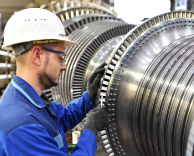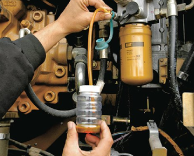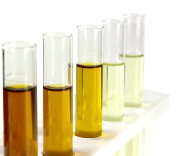Over greasing: The Silent Killer of Your Equipment and How to Avoid It
Introduction: The Commonly Ignored Peril of Over-Greasing
When it comes to your industrial machinery, maintenance is
synonymous with keeping your equipment in top-notch condition. But
what is sometimes overlooked, yet can also have considerable
adverse effects, is over-greasing. Although most companies take
desired steps to keep machinery well lubricated, most have no idea
that over lubrication can lead to expensive machine breakdown,
unplanned downtime, and irreversible failures.
In this article, we will discuss the hazards of over-greasing,
why it happens, and how to prevent it and keep your equipment
running as it should.
What is Overgreasing?
Over-greasing is simply applying too much grease to a component, often in excess of the recommended amount. In theory, if a little lube improves the performance of your equipment, then more lube should help it even better, right? Wrong! Too much grease leads to a variety of issues that reduce machinery performance and spoil equipment in the long term.
Common Causes of Overgreasing
Excessive Greasing Over-greasing often happens for several reasons, including:
- Misunderstanding: Operators might not even know the proper amount of grease for each component and feel that extra lubricant will help.
- Inadequate Maintenance Schedules: When preventive maintenance schedules are not carried out on a regular basis, over-greasing happens when equipment receives more grease than required during regular service.
- Defective Grease Guns: A grease gun that is malfunctioning or set at the incorrect pressure can push out too much grease, which will cause over-greasing.
- Improper Greasing Procedures: In some cases, lubricant methods that are not strictly adhered to according to the manufacturer can lead to excess grease being applied.
The Dangers of Overgreasing
1. Increased Friction and Heat
Also, any grease in excess may not get completely dispersed or circulated throughout the system, which means that heat may build up inside the bearings and seals. This can accelerate friction and decrease the efficiency of the lubrication, which could lead to the swift degradation of critical elements. It becomes even worse for high-speed, high-load applications where overheating is catastrophic and can damage the circuit.
2. Seal and Bearing Damage
Too much grease can put pressure on the seals, which can get deformed or leak. As the seals break down, dirt, water, and dust will also enter the system, increasing bearing wear. It can lead to early bearing failure, which will be an expensive replacement.
3. Blocked Lubrication Pathways
Excess grease may even clog the lubrication system, so that the grease is never delivered to the most vulnerable parts of the equipment. Such a blockage can stop the important lubricant from getting to areas where it is required the most and may cause damage to moving parts.
4. Increased Energy Consumption
Over-greasing can put some resistance into the system, making the system work harder to move. This extra drag increases the amount of energy consumed and thereby increases operational costs and reduces efficiency.
5. Environmental Impact
It also produces an ecological effect from overgrazing. When too much grease is used, it can leak into the environment via seals and ventilation, which results in pollution. This can negatively impact native ecosystems and lead to expensive remediation.
Calculating the Correct Amount of Grease
The Grease Calculation Formula
To determine the right amount of grease for a bearing, you can use
the following formula:
Amount of Grease (oz)=Bearing Diameter (in)×Width (in)×0.114
Example Calculation
For a bearing with an outside diameter of 3 inches and a width of
0.5 inches:
3×0.5=1.5 (Bearing Volume)
1.5×0.114=0.17 oz (or 4.8 grams)
Thus, 0.17 ounces or 4.8 grams of grease is required.
Solving Overgreasing Issues:
Significance of Frequency Regulation
After you learn how much grease to use, the second most important factor to master is how often to grease. Use lubrication intervals from industry charts or tables
Best and Tools Techniques to Avoid Over-greasing:
- Calibrate Grease Guns: Get the correct pump volume.
- High Pressure: Terminate the greasing process immediately once abnormal pressure is detected.
- Select Appropriate Tools: Manual grease guns are inexpensive and enable inspection of equipment, but may contribute to over-under lubrication through poor control.
Finding Perfect Adequate Grease
Achieving this ever-elusive optimum of avoiding overgreasing or undergreasing depends upon multiple factors, namely equipment type, operating conditions, grease specification and type, and other factors.
1. Type of Equipment and Load Conditions
Practical Knowledge of Mechanical Lubrication Prevention– Heavy-duty machines such as crushers and mills, and turbines operate at a higher load and more frequently; hence, they require a higher amount of lubrication. For lighter-duty equipment such as fans or conveyors, actual washing may not be necessary. It is, therefore, important to understand what your equipment requires when it comes to lubrication to ascertain proper doses.
2. Operating Environment
Machines running in dusty or wet conditions require more frequent lubrication to prevent contamination. Less may be required for machines operating in controlled or clean environments. Additionally, in high heat, grease can become too liquid and more will be needed.
3. Grease Type and Consistency
The quantities required will vary considerably based on the type of grease used. Not all greases have the same level of viscosity and temperature resistance. The high-temperature grease or other special-purpose greases might need more frequent application than an ordinary grease.
4. Grease Application Methods
How grease is applied also heavily influences the right amount. In comparison to far more automatic and accurate systems, if you have to use a manual grease gun, you can either over or under grease. A centralized lubrication system can provide proper grease balance to the entire operation.
Follow to more information - Click Here
Greasers and the New Greasing Best Practices
If you want to keep your machinery well-lubricated, observe the following best practices:
1. Follow These Manufacturer Recommendations
Whenever you lubricate, always adhere to M/ T recommendations. Such guidelines entail information about the specific type of grease, quantity, and, application intervals, etc. These are developed after extensive testing to ensure the durability and reliability of the equipment.
2. Always Check The Amount Of Grease
Periodic monitoring of grease levels can uncover problems such as overgreasing or undergreasing before they result in severe harm. Inspect grease reservoirs and add new grease where required. Employ measuring devices such as force meters and pressure gauges for a more precise measurement.
3. Acquisition of Automatic Lubrication Systems
An automatic lubrication system has a greater level of accuracy when it comes to applying grease and ensures that the proper amount of grease is used by dispensing at accurate intervals. Well-integrated, these systems reduce the chance of human error and increase the efficiency of the overall maintenance process.
4. Avoid Grease Contamination
Dirt, moisture and debris can easily contaminate Grease and render it useless. All grease pumps, reservoirs, and application points should be clean and free from contaminants. Filters shall, if necessary, be used to separate impurities from the grease prior to its application to equipment.
5. Educate Your Team
It takes a talented crew to give good lube. Educate your maintenance personnel about grease — proper greasing, over & under greasing dangers and how much grease to apply. Frequent practice on lubricating upkeep makes any involved personnel conscious of lubrication as regards the well-being of the equipment.
Conclusion
One of the most common issues with machinery maintenance is over-greasing and under-greasing. Ensure equipment will last with proper grease calculation, controlled frequency and a sophisticated maintenance program.
Learn more about our services and industry insights by visiting our official LinkedIn page: Minimac Systems
FAQs:
A: Over-greasing can cause:
● Compound friction, heat, and then with it comes the wear of parts.
● Excursion of seal damage of contamination.
● Impeded lubrication channels, preventing grease to flow into the areas of importance.
● More operational cost as it increases the energy cost
● Ground pollution from leaking grease
● Grease guns should be calibrated to deliver the correct amounts.
● While pumping grease, keep an eye out for pressure. Please ensure that you stop if you feel any resistance.
● Adopt automatic lubrication systems for precision.
● Excessive grease that came out of a seal or vent.
● More resistance within the machinery, requiring higher energy consumption.
● Remove the excess with a clean cloth.
● Apply the appropriate amount of grease according to the manufacturer specifications.
● Thickener — This keeps the grease thick
● Additives: Designed to improve characteristics such as corrosion resistance, wear resistance, as well as high-temperature resistance.




